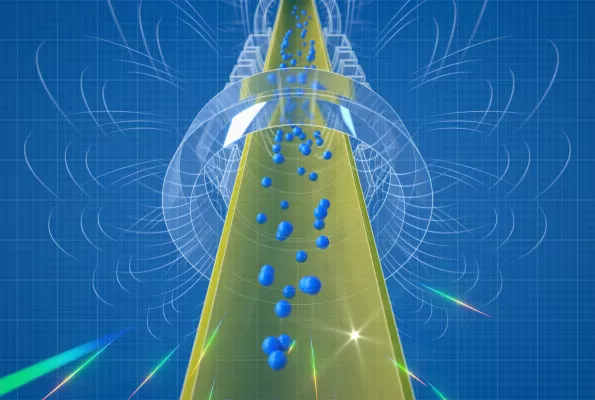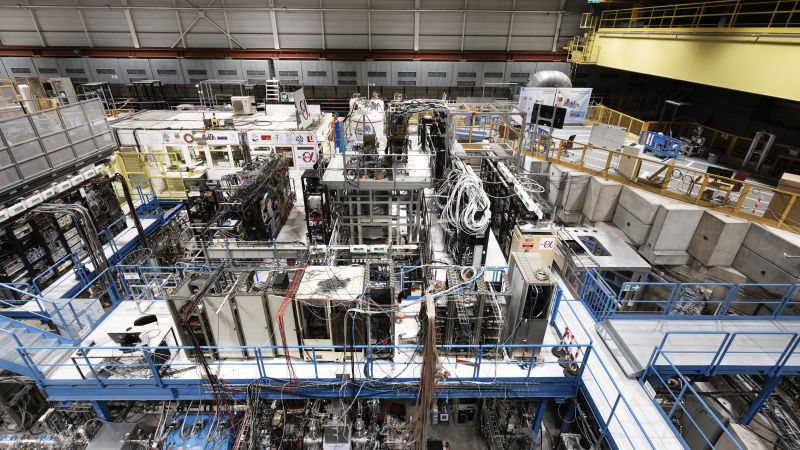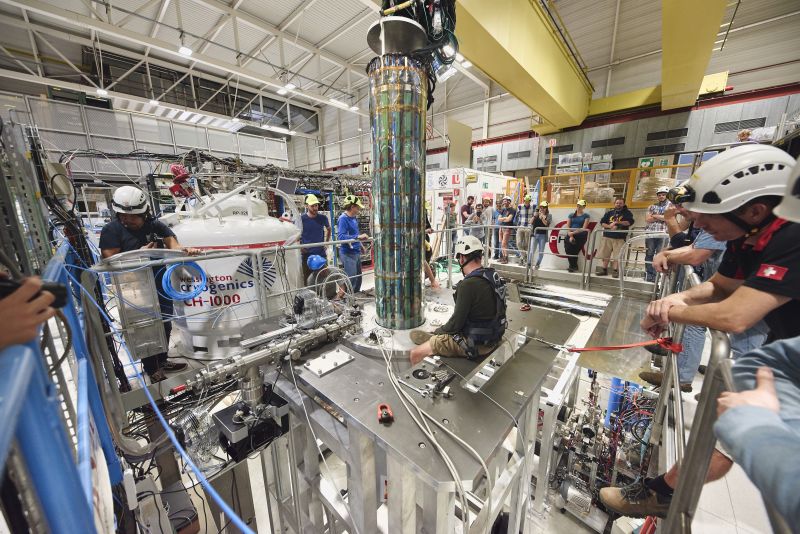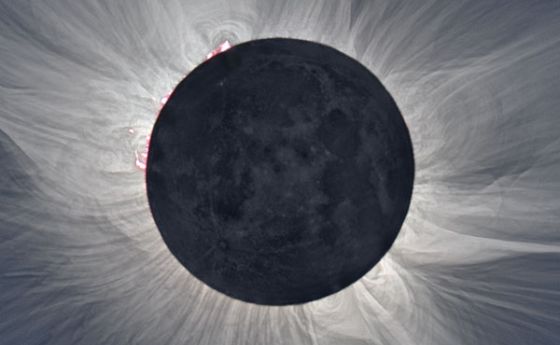
Down goes antimatter! Gravity's effect on matter's elusive twin is revealed
Landmark CERN experiment answers longstanding question of whether antimatter and matter are gravitationally attracted or repelled
If you dropped some antimatter, would it fall down or up? Scientists now know the definitive answer: down. That is, if you can somehow prevent it from exploding into pure energy long enough to see where it goes.
A scientific paper describing the landmark experiment behind that conclusion is published today in the journal Nature and comes from the international Antihydrogen Laser Physics Apparatus (ALPHA) collaboration at the European Organization for Nuclear Research (CERN) in Switzerland. The ALPHA collaboration's unique, painstaking experiment has answered the longstanding fundamental question about whether antimatter is gravitationally attracted or repelled by regular matter by observing the downward path taken by individual atoms of antihydrogen. Their work also provides a key piece in one of the most immense unsolved puzzles in science — why is there so little antimatter in the observable universe?
CERN's ALPHA collaboration is supported by more than a dozen countries and private institutions, including the U.S. through the joint U.S. National Science Foundation/Department of Energy Partnership in Basic Plasma Science and Engineering program.
"Einstein's theory of general relativity says antimatter should behave exactly the same as matter," says University of California, Berkeley, plasma physicist and ALPHA collaboration member Jonathan Wurtele. "Many indirect measurements indicate that gravity interacts with antimatter as expected, but until the result today, nobody had actually performed a direct observation that could rule out, for example, antihydrogen moving upwards as opposed to downwards in a gravitational field."
Matter's elusive, volatile twin
Beyond the imagined antimatter-fueled warp drives and photon torpedoes of "Star Trek," antimatter is completely real yet mysteriously scarce. Our bodies, the Earth and most everything else scientists know about in the universe are overwhelmingly made of what scientists call baryonic matter. That's the stuff made mostly of regular protons and neutrons, like oxygen, carbon, iron and other familiar elements on the periodic table.
Antimatter, on the other hand, is regular matter's twin — except that it has some opposite properties depending on the particular type of particle. For example, antiprotons have a negative charge while protons have a positive charge. Similarly, antielectrons (also known as positrons) are positive.
Antimatter also has another property that makes it uniquely challenging to work with:
"As soon as antimatter touches matter, it blows up," says ALPHA collaboration member and UC Berkeley plasma physicist Joel Fajans. The combined mass of the matter and antimatter is transformed entirely into energy in a reaction so energetic that "explosion" doesn't do it justice.
Scientists call it an "annihilation."
"For a given mass, such annihilations are the densest form of energy release that we know of," says Fajans.
But not to worry. The amount of antimatter used in the ALPHA experiment is so small that the energy created by antimatter/matter annihilations is imperceptible to humans. Instead, highly sensitive detectors must be used. "Still, we have to manipulate the antimatter very carefully or we will lose it," says Fajans.
Dropping an antimatter banger
Nearly two decades in the making, the sprawling ALPHA experiment resides in a building labeled "Antimatter Factory" outside Geneva, where antihydrogen is created from scratch by combining antiprotons and positrons in a labyrinthine process. The antiprotons are created and provided to the ALPHA experiment by the CERN particle accelerator complex. The positrons are acquired from an artificial radioactive isotope of sodium which emits them. Both antiparticles are cooled to near room temperature and form plasmas, the fourth state of matter (solid, liquid and gas are the other three).
The antiproton and positron plasmas are then routed into a vertical chamber called ALPHA-g, where the gravity experiment will eventually be performed.
"The vast majority of the experimental time is spent doing plasma manipulations to get these antiparticle plasmas into the shape and temperature that we need them to be," says Fajans. "We have to cool them to about 10 degrees Kelvin — that's 10 degrees above absolute zero — and we must form them into needle-like shapes.”
"Plasmas are normally the hottest form of matter," explains Wurtele. "But we need to cool them to temperatures where almost everything would typically be solid or liquid."
Once the proper conditions are attained, the plasmas are mixed together with exacting precision inside the ALPHA-g chamber to create the precious antihydrogen atoms.
"Broadly speaking, we're making antimatter, and we're doing a Leaning Tower of Pisa kind of experiment," says Wurtele, referring to ALPHA-g's somewhat simpler intellectual ancestor, Galileo's legendary (and perhaps apocryphal) 16th century experiment demonstrating identical gravitational acceleration of two simultaneously dropped objects of similar volume but different mass.
"We're letting the antimatter go, and we're seeing if it goes up or down."
The antihydrogen is contained within ALPHA-g's cylindrical vacuum chamber using a variable magnetic trap, which prevents the antimatter from touching the walls of the chamber and annihilating. The scientists reduce the strength of the trap's top and bottom magnetic fields until the antihydrogen atoms can escape, and the relatively weak influence of gravity becomes apparent. As each antihydrogen atom escapes the magnetic trap, it touches the chamber walls either above or below the trap and annihilates, which the scientists can detect and count.
The researchers repeated the experiment more than a dozen times, each time varying the magnetic field strength of the top and bottom of the trap to rule out possible errors. They observed that when the weakened magnetic fields were precisely balanced at the top and bottom, about 80% of the antihydrogen atoms annihilated beneath the trap — a result consistent with how a cloud of regular hydrogen would behave under the same conditions.
Thus, gravity was causing the antihydrogen to fall down.
"Previously, there have been many indirect observations that strongly suggest that antimatter gravitates normally," says Fajans. "But none of those observations were as incontrovertible as following the trajectories of antimatter under the influence of gravity; they all relied on much more subtle phenomena."
The matter/antimatter mystery
As you've probably noticed, there are not antimatter people walking around and annihilating in colossal explosions. In fact, despite some very modest sources of antimatter — like naturally occurring positrons emitted from potassium, including inside bananas — we don't see much antimatter anywhere in the universe. That is counter to the laws of physics, which predict that antimatter should exist in roughly equal measure with regular matter.
"For the most part, we live in a universe of matter. And one big question is 'why?'," says Tim Tharp, an ALPHA collaboration member and plasma physicist at Marquette University. "There isn't a lot of antimatter around, and we don’t really understand why the universe developed this preference."
Scientists call this conundrum the baryogenesis problem. One potential explanation for the scarcity of antimatter is that it was gravitationally repelled by regular matter during the Big Bang, causing it to shoot off to some distant part of the universe that we can't see. That theory no longer seems plausible.
"We've ruled out antimatter being repelled by the gravitational force as opposed to attracted, but that doesn't mean there isn't a difference in the gravitational force on antimatter that has not yet been measured," Wurtele says. The force of gravity on antimatter may be weaker or stronger than regular matter, which requires a more precise measurement to determine.
The ALPHA collaboration researchers will continue to probe the nature of antihydrogen in search of some contrarian aspect. In addition to refining their measurement of the effect of gravity, they are also studying how antihydrogen interacts with electromagnetic radiation through spectroscopy.
"If antihydrogen were somehow different from hydrogen, that would be a revolutionary thing because the physical laws, both in quantum mechanics and gravity, say the behavior should be the same," says Wurtele.
"However, one doesn't know until one does the experiment."







